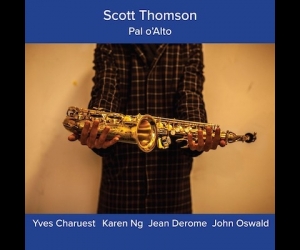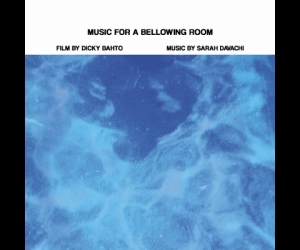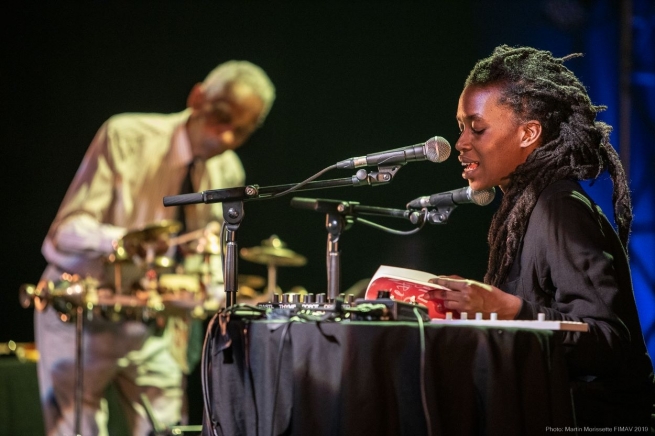
There has always been something slightly enchanted about FIMAV’s existence. Sheltered in a small city between Montreal and Quebec City, Festival International de Musique Actuelle de Victoriaville is devoted to musique actuelle (music of the moment), which embraces improvised music, free jazz, avant-rock, electronica, harsh noise, folkloric projects, and uncategorizable sonic eruptions from around the world. Today, that notion of a music beyond genre may be the best description available when a tárogató, a pedal steel guitar, and a computer might share a stage. This year marked both the festival’s thirty-fifth edition—a tribute to the vision and practical skills of artistic director Michel Levasseur—and the tenth instalment of the festival’s exhibition of sound sculptures, a community gateway to creative engagement with sound. In twenty-one performances over four days, FIMAV demonstrated its remarkable breadth, presenting unique musical combinations ranging from the cool laboratory brilliance of Swiss composer Tomas Korber’s electronic interaction with the saxophones of Konus Quartett to the transformative, shamanic energies of Indonesian duo Senyawa in combination with Japanese improviser Keiji Haino.
FIMAV’s roots are deep, as evidenced this year by a trinity of senior performers who continue to produce provocative work. Fifty years after the Art Ensemble of Chicago took Paris, saxophonist-composer Roscoe Mitchell, who is seventy-eight, forced rage and pathos through the narrow bore of a sopranino saxophone in a series of honks, squeaks, and gasps in a duo with Moor Mother (aka poet and performance artist Camae Ayewa), who assembled an hour’s diatribe, The Black Down, out of repetitions of a few loaded phrases like “muddy waters” and “can’t be satisfied.” [TOP PHOTO]
Saxophonist Peter Brötzmann—who is also a half century on from his groundbreaking work, Machine Gun—appeared in his long-standing duo with pedal steel guitarist and singer Heather Leigh. The duo, which matches Brötzmann’s existential roar with Leigh’s angelic voice and ringing, ethereal chords, is unlikely enough, but it was further paired with Keiji Haino, a force of nature who can range from sublime to terrible. Here he presented the Brötzmann-Leigh dialogue with everything from inchoate masses of distorted guitar to waves of shimmering electronic percussion.
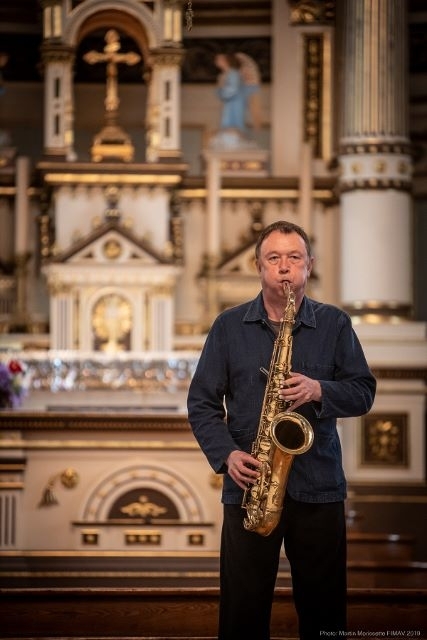
The eldest of FIMAV’s returning seniors may have been the most musically germane. Now eighty-four, Barre Phillips, who released what is reputed to be the world's first album of solo bass improvisations in 1968, brought levels of technique, detail, and resonance that were still arresting, whether he was developing elaborate patterns of harmonics or using the bow frog as a percussion instrument to tap out rapid, upper-register runs. Such solo concerts have long been FIMAV highlights. This year the Église Saint-Christophe d'Arthabaska housed a stellar acoustic one by English saxophonist John Butcher [ABOVE] who began on tenor, emitting multiphonic blasts of sound and withdrawing the horn from his lips as the church echoed in response. The dialogue continued for an hour, with Butcher switching between tenor and soprano, developing continuous and expanding textures; none was less than brilliant, and in one soprano piece, he and the church created an unthinkable stretch of cascading, overlapping runs featuring his circular breathing to enter realms in which Bach and Coltrane seemed like familiars.
The same sense of larger harmonies arose in Montreal composer Rainer Wiens’ Birds of a Feather. Recalling Olivier Messiaen’s immersion in bird calls, the piece for thirteen musicians included extended improvisations on various bird songs, with Wiens using conduction to assemble and disperse his ever-shifting flock. Notable solo contributions came from clarinetists Lori Freedman and Elizabeth Millar, flutist Jean Derome, and saxophonist Yves Charuest.
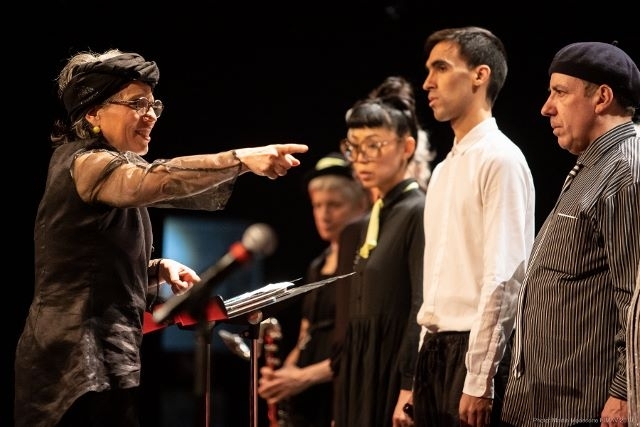
Freedman and Derome also appeared in Les Lucioles, another arresting large-scale creation from the Montreal community. Joane Hétu’s Joker, a twenty-two-member choir [PHOTO ABOVE], created a kind of folk-art circus that enlisted numerous instrumentalists as singers, while a few got to play instruments as well. Hétu, Derome, and Danielle Palardy Roger acted as composers and conductors in a work that combined rustic costumes, high-spirited vocals, and large theatrical gestures. FIMAV’s embrace of large projects also included Vancouver composer-cellist Peggy Lee’s Echo Painting, the festival’s opening concert. Lee’s writing for the tentet has a cinematic sweep with orchestral textures cut together with improvised solos, from Lee and violinist Meredith Bates’ adventures in harmonics to the warm jazz of Jon Bentley and the electronic squall of guitarist Cole Schmidt.
The festival’s special status was evident in the quality and diversity of music from further afield. The New York repertory group Bang on a Can All-Stars presented material from their Field Recordings project and from Bang on a Canada, a project in which composers were commissioned to create pieces for the ensemble using found materials. It’s an entertaining, creative collection of works that includes Christian Marclay’s Fade to Slide, in which the ensemble integrated itself with the rapidly changing sounds of a video collage. The strong Canadian content including Julia Wolfe’s Reeling, which is based on an a capella Québécois reel, while René Lussier’s Nocturne contained barnyard snoring.
Different dimensions of current New York jazz were also strongly represented. Pianist Vijay Iyer’s sextet worked forward from a post-bop tradition, while composer-drummer Tyshawn Sorey—who is also a member of Iyer’s group—led his own trio with pianist Corey Smythe and bassist Chris Tordini in a powerful, uninterrupted hour-long sequence in which the group achieved Cecil Taylor-like levels of energy while creating original shapes in relationship to the arcing structural components. It was one of several festival highlights.
Musicians from Europe, however, provided the greatest variety. Norwegian composer-guitarist Kim Myhr presented his minimalist epic You | Me, for a band of four guitarists and three percussionists. It began with a rainfall of bright trebles before settling into the unison reiteration of a brief pattern of guitar chords that created oceanic washes, followed by electric guitars at the outset, a percussion interlude in the middle, and then acoustic guitars with electric solos. The hypnotic You | Me (performed by a band of leading Scandinavian improvisers that included guitarist David Stackenäs and percussionists Ingar Zach and Toma Gouband) was a utopian isle amidst some challenging seas.
The duo of French horn player Elena Kakaliagou and prepared-piano specialist Ingrid Schmoliner presented an intimate and moving exploration of folk tales from the mountainous regions of their native Greece and Austria, with Kakaliagou providing the bulk of the connecting narrative and vocals. The subtle marriage of stories of magic and struggle to advanced techniques—Schmoliner’s rhythmic power and mastery of percussive and orchestral piano preparation; Kakaliagou’s subtle timbral mutations and circular breathing—gave the performance its distinctive charm.
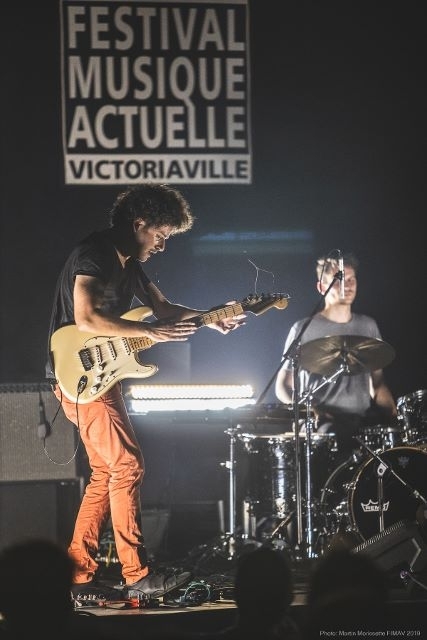
No festival could be more appropriate for the North American debut of French guitarist Julien Desprez [PHOTO ABOVE], here with his trio Abacaxi. Desprez plays guitar and pedals with the unimaginable precision of a robot from the future, hand jumping from headstock to bridge, picking strings and punching the body and fingerboard, all of it in lock-time with a literal dance on a pedal board that not only mutates and distinguishes every nanosecond of sound but controls a light show from black-out to incendiary flare, all of this resulting in a music that simultaneously invokes Hendrix, Webern, and video games. He’s the most dramatic figure to emerge in improvised music in decades.
But it was in the subtler performers, though, that one glimpsed the ongoing evolution and contribution of FIMAV, both to Québécois and Canadian creative music. The Montreal-based duo Political Ritual—Maxime Corbeil-Perron and Félix-Antoine Morin—combined synthesizers, objects, and prepared and invented instruments to create a powerful soundwork, in which electronic sound became continuous with the natural world, oceanic waves of sound surmounted by tiny details in a narrative of consciousness itself. The duo Not the Music focused more on discrete, even, acoustic sounds, with a continuous sense of an inflected, unfolding line. Philippe Lauzier’s elegant bass clarinet entwined with Éric Normand’s electric bass and a snare drum that provided an operating surface for windup toys.
True to its original mission, FIMAV is a festival that thrives on a certain degree of creative risk. In its less inspired moments or occasional miscalculations, it can feel like a weird smorgasbord, but at its best, it’s a banquet of rare and sometimes unknown sounds well worth exploring.
All FIMAV 2019 photos by Maratin Morissette.
